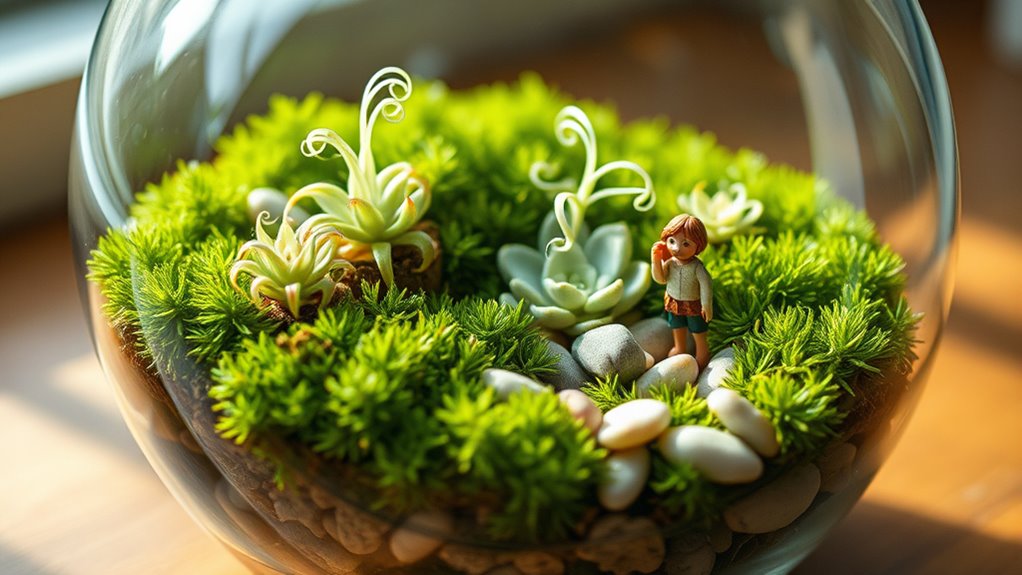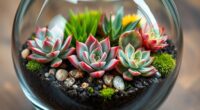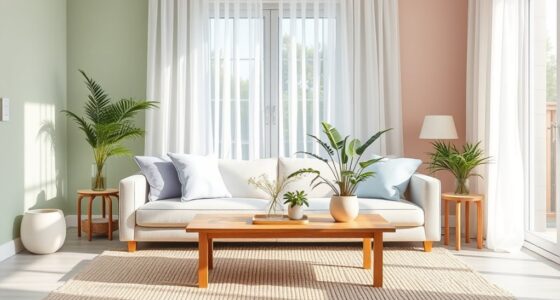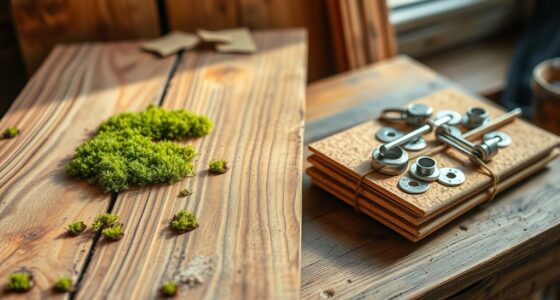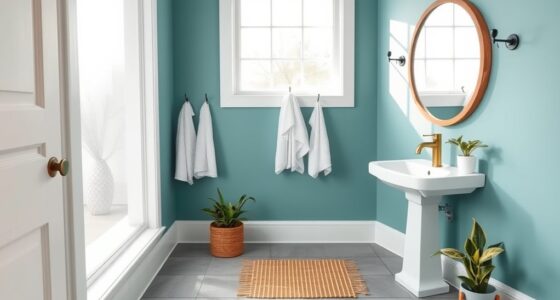To bring nature indoors with a DIY terrarium, start by selecting a clear glass container and adding drainage layers like gravel, activated charcoal, and well-draining soil suited for succulents. Choose a variety of colorful, different-sized succulents and arrange them thoughtfully, placing decorative stones or sand on top. Place the terrarium near bright, indirect light and water lightly when needed, avoiding over-watering. With some care and customization, your indoor garden will thrive—discover more tips to perfect your green space.
Key Takeaways
- Select clear glass containers and layer drainage materials like pebbles, activated charcoal, and soil for a healthy environment.
- Choose diverse succulents and arrange them at varying heights for visual interest and growth space.
- Place the terrarium near bright, indirect sunlight and rotate regularly to ensure even light exposure.
- Water lightly using a spray bottle, avoiding over-watering to prevent root rot and maintain soil moisture.
- Personalize your terrarium with decorative elements and periodically update plants for a living, artistic indoor garden.

Have you ever wondered how to create your own miniature garden indoors? Crafting a DIY terrarium is an engaging way to bring a touch of nature inside your home. Whether you’re a beginner or an experienced gardener, assembling succulent arrangements within a glass container can turn any space into a lush, vibrant miniature ecosystem. These tiny worlds require minimal maintenance and serve as a calming, decorative centerpiece that highlights your creativity.
Start by selecting a clear glass container that suits your style. It can be a simple jar, a fishbowl, or an ornate vase—any transparent vessel works. Next, prepare the base layer by adding small pebbles or gravel for drainage. This prevents excess water from sitting at the roots, reducing the risk of rot. Follow this with a layer of activated charcoal, which helps filter the air and keeps your miniature ecosystem fresh. Then, add a layer of potting soil suitable for succulents, which need well-draining soil to thrive.
Choose a transparent glass vessel, add drainage layers, and fill with well-draining soil for thriving succulents.
Now, it’s time to create your succulent arrangements. Choose a variety of succulents with different shapes, colors, and sizes to add visual interest. When planting, gently remove each succulent from its nursery pot, loosen the roots, and place them into the soil at different heights and angles. Space them out sufficiently to allow growth but keep them close enough to create a cohesive display. Use small tools or tongs to position them precisely, and add decorative stones or sand on top for a finished look. Remember, succulents love bright, indirect light, so place your terrarium near a window that receives plenty of sunlight.
As you assemble your miniature ecosystem, consider incorporating decorative elements like tiny figurines, shells, or miniature furniture to personalize your space. These touches add character and charm, transforming your terrarium into a miniature world that reflects your personality. Once everything is in place, water lightly—succulents need less water than other plants, so err on the side of under-watering. Use a spray bottle or a small watering can to deliver just enough moisture to keep the soil slightly damp.
Maintaining your DIY terrarium involves occasional watering, removing dead leaves, and rotating it to ensure even light exposure. Since succulents are drought-tolerant, they’re forgiving if you forget to water for a week or two. Additionally, understanding the role of color accuracy in your environment can help you choose optimal lighting conditions that enhance your plants’ natural colors and health. Over time, you can experiment with different plant combinations or add new elements to keep your miniature ecosystem fresh and engaging. Creating your own terrarium is more than just a craft; it’s a rewarding way to connect with nature and enjoy a living piece of art right in your home.
Frequently Asked Questions
What Are the Best Plants for Outdoor Terrariums?
When choosing plants for outdoor terrariums, you want to pick hardy options that thrive in outdoor conditions. Succulent varieties are perfect because they handle sunlight and dry air well. Additionally, air purifying plants like ferns or pothos can improve air quality and add lush greenery. Make sure to select plants that match your climate and provide proper drainage to keep your outdoor terrarium healthy and vibrant.
How Often Should I Water My Terrarium?
Think of watering your terrarium as walking a tightrope—you don’t want to overdo it or leave it parched. Typically, you should water your terrarium every 2-4 weeks, adjusting for its humidity levels. Keep an eye on soil moisture; if it feels dry, give it a light drink. Proper watering frequency guarantees your plants flourish without excess moisture that could cause rot or mold.
Can I Use Artificial Plants in My Terrarium?
You can absolutely use artificial plants or faux greenery in your terrarium. They’re a great low-maintenance option if you want a lush look without watering or sunlight. Artificial plants add color and texture, making your terrarium visually appealing. Just make certain you choose high-quality faux greenery that complements your overall design. Incorporating artificial plants can create a vibrant, long-lasting display while reducing care requirements.
How Do I Prevent Mold Growth Inside the Terrarium?
Imagine you set up a lush terrarium, but mold quickly appears. To prevent mold growth, focus on terrarium hygiene by removing excess moisture and avoiding overwatering. Use a layer of activated charcoal to absorb odors and moisture, and guarantee good airflow. Regularly inspect your setup and clean any mold promptly. These steps help maintain a healthy environment, ensuring your indoor garden stays vibrant and mold-free.
Are There Eco-Friendly Materials for Creating Terrariums?
You ask about eco-friendly materials for creating terrariums. You can use sustainable substrates like coconut coir, peat moss, or composted bark to reduce environmental impact. Biodegradable containers made from materials like cardboard, bamboo, or recycled paper are great options for eco-conscious terrariums. These materials help minimize waste and are biodegradable, making your project more sustainable while still creating a beautiful, natural indoor garden.
Conclusion
Creating your own terrarium is a delightful way to subtly invite nature into your space. With a little imagination and care, you craft a miniature world that quietly enriches your environment. As you tend to it, you’ll find serenity blossoming alongside your plants, offering a gentle reminder of life’s delicate beauty. Embrace this simple yet elegant endeavor, and let your indoor garden serve as a refined sanctuary of natural charm.
